Volvo Group Bundle
How did a Swedish car manufacturer become a global industrial giant?
Journey back to 1927, when the first Volvo Group SWOT Analysis was born, marking the inception of a company destined to reshape global transportation. From its roots in Gothenburg, Sweden, Volvo Group emerged with a commitment to safety and quality, quickly evolving beyond its automotive beginnings. Today, it's a powerhouse in commercial transport and infrastructure, a stark contrast to its initial focus on Volvo cars.
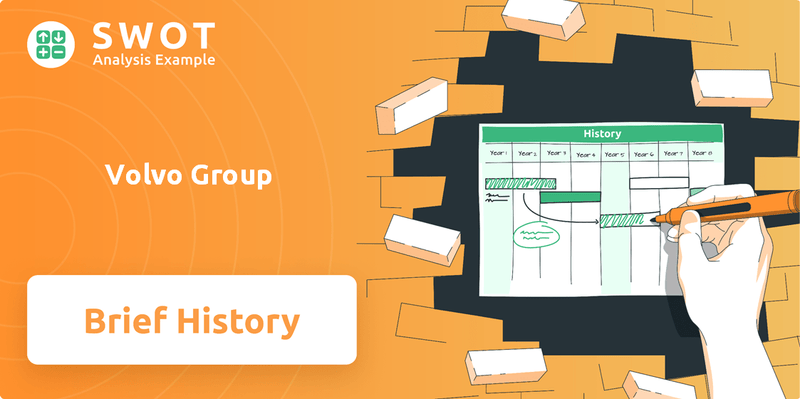
This article delves into the brief history of Volvo Group company, tracing its remarkable evolution from a car manufacturer to a multinational industrial leader. Explore the key milestones, innovations, and challenges that have shaped Volvo Group's trajectory, including its impact on the industry through Volvo trucks, Volvo construction equipment, and beyond. Discover how Volvo Group's commitment to innovation and sustainability has solidified its global presence and competitive edge.
What is the Volvo Group Founding Story?
The Volvo Group's story began on April 14, 1927, in Gothenburg, Sweden. This marked the official founding of the company by Assar Gabrielsson and Gustaf Larson. Their vision was to create vehicles specifically designed for the demanding conditions of Sweden.
Gabrielsson, with a background in sales and economics, saw the potential for a Swedish car manufacturer. Larson, an engineer, provided the technical expertise. Their collaboration was driven by a shared belief in the need for high-quality, durable, and safe vehicles, addressing the lack of robust cars suitable for Swedish roads.
The initial business model focused on assembling vehicles using components from various suppliers, emphasizing quality and durability. The company's first product was the ÖV 4, an open touring car, soon followed by the PV4 sedan. The name 'Volvo,' Latin for 'I roll,' was originally a trademark of SKF, a bearing manufacturer, and was secured by Gabrielsson and Larson for their automotive venture. Initial funding came from SKF, which also provided factory space.
The early years of Volvo history were marked by a focus on building vehicles suited for the challenging Swedish environment. The company's foundation was built on quality and durability.
- The company's initial focus was on producing vehicles suitable for the Swedish market.
- The first vehicles, the ÖV 4 and PV4, were designed with durability in mind.
- SKF provided initial financial backing and factory space.
- The name 'Volvo' was adopted from a registered trademark.
The economic context of post-World War I Sweden, with its growing industrialization, provided a favorable environment for the establishment of the Volvo company. The demand for reliable transportation was on the rise, creating a market for the company's products. The company's early success set the stage for its future growth and expansion into various segments, including Volvo trucks and Volvo construction equipment.
In 2024, the Volvo Group reported net sales of SEK 571.3 billion, with an adjusted operating margin of 11.8%. The company's focus on sustainable transport solutions is evident in their investments in electric and autonomous vehicles. The company's commitment to innovation and sustainability continues to drive its evolution and impact on the industry. You can learn more about the company's target market in this article: Target Market of Volvo Group.
Volvo Group SWOT Analysis
- Complete SWOT Breakdown
- Fully Customizable
- Editable in Excel & Word
- Professional Formatting
- Investor-Ready Format
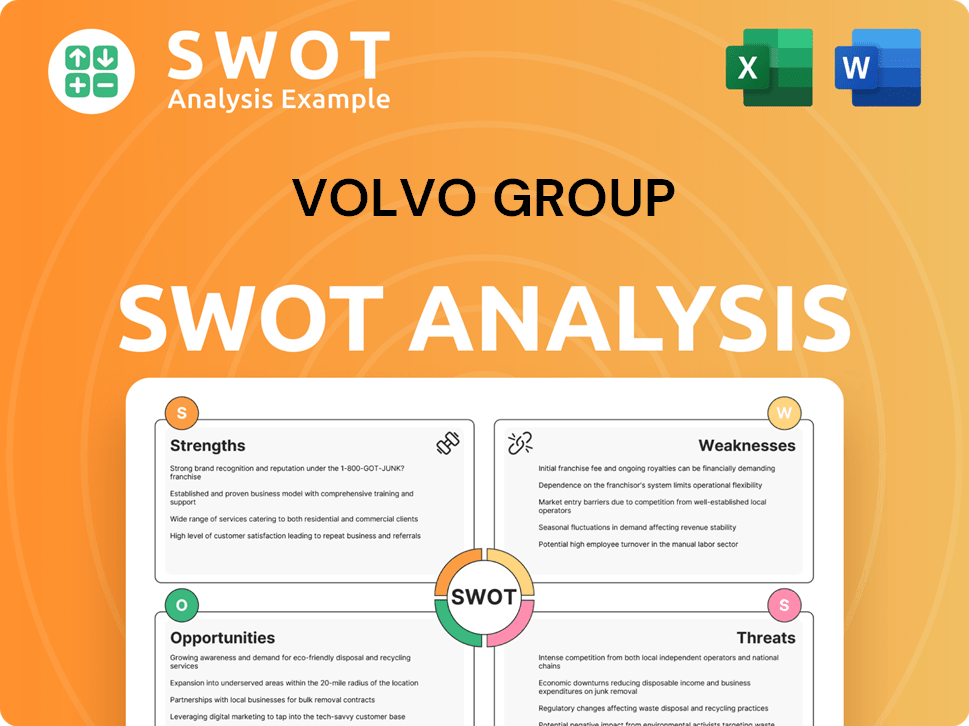
What Drove the Early Growth of Volvo Group?
The early growth of the Volvo Group was marked by a strategic emphasis on quality and diversification. Following the launch of its initial cars, the Volvo company quickly recognized the potential in commercial vehicles. This shift proved crucial as truck sales soon outpaced car sales, establishing a core aspect of Volvo's business model. Early major clients included various Swedish businesses and public services.
In 1928, Volvo produced its first truck, the Series 1, marking a significant entry into the commercial transport sector. This diversification was key to its early success. By expanding into Volvo trucks, the company broadened its market reach and revenue streams.
The initial team expanded, and production facilities grew beyond the original SKF factory. Volvo began exporting its vehicles in the 1930s, cautiously entering new geographical markets, primarily within Europe. Key leaders like Gabrielsson and Larson guided the company through its formative years.
The company navigated the economic challenges of the Great Depression by maintaining its focus on durable and dependable products. This approach resonated with customers seeking long-lasting investments. Volvo's commitment to quality helped it weather economic downturns.
During this period, Volvo's engineering prowess and commitment to safety began to distinguish it from competitors. The market reception was positive, particularly for its robust trucks, which proved well-suited for heavy-duty applications. This early growth solidified Volvo's position in the Nordic automotive industry. For more insights, check out the Marketing Strategy of Volvo Group.
Volvo Group PESTLE Analysis
- Covers All 6 PESTLE Categories
- No Research Needed – Save Hours of Work
- Built by Experts, Trusted by Consultants
- Instant Download, Ready to Use
- 100% Editable, Fully Customizable
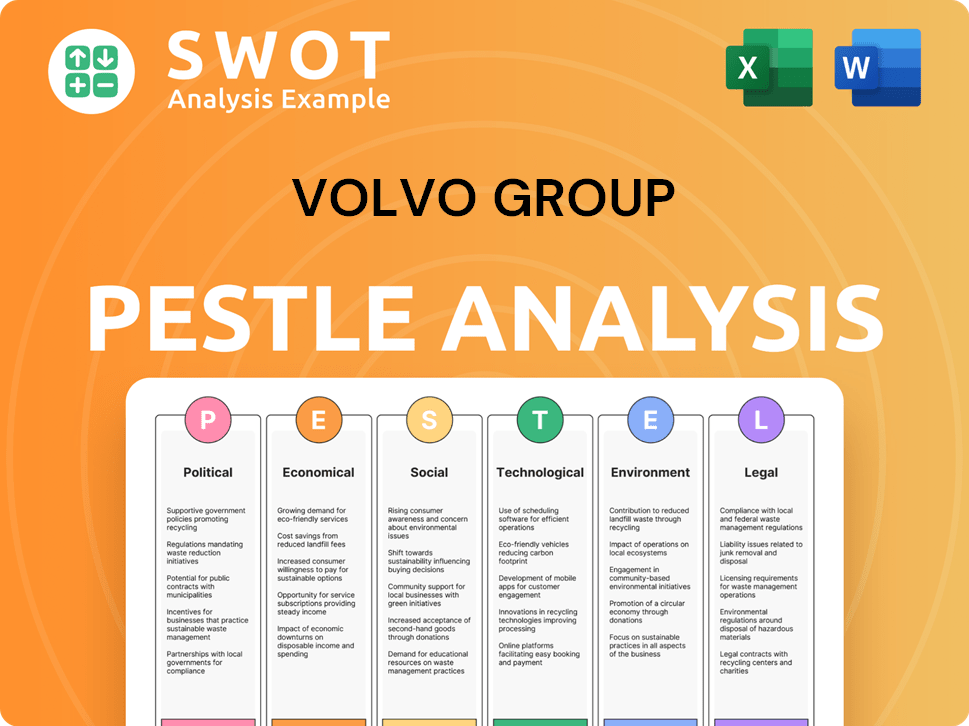
What are the key Milestones in Volvo Group history?
The Volvo Group, a significant player in the automotive and construction equipment industries, has a rich Volvo history marked by several key milestones. Understanding the Volvo company's journey provides valuable insights into its current position and future prospects.
| Year | Milestone |
|---|---|
| 1927 | Volvo Group was founded in Gothenburg, Sweden, initially producing automobiles. |
| 1959 | Introduction of the three-point safety belt, an industry-first safety innovation. |
| 1999 | Divestiture of Volvo cars to Ford, focusing on commercial vehicles and construction equipment. |
| 2018 | Unveiling of the Vera autonomous electric truck, showcasing advancements in automation. |
| 2022 | Commenced sales of heavy-duty electric trucks in Europe, marking a shift towards sustainable transport. |
Volvo Group has consistently demonstrated innovation in its products and services. The company has been at the forefront of developing cleaner engine technologies and electric vehicles to meet environmental standards.
The three-point safety belt, introduced in 1959, revolutionized vehicle safety and was made available to all manufacturers. This innovation helped Volvo Group to establish itself as a leader in vehicle safety.
Volvo trucks began selling heavy-duty electric trucks in Europe in 2022, and by early 2024, had delivered over 6,000 electric trucks globally. This demonstrates the company's commitment to sustainable transport solutions.
The development of autonomous driving technologies for commercial vehicles, such as the Vera autonomous electric truck, represents a significant advancement. These technologies aim to improve efficiency and safety in logistics.
Volvo Group has faced several challenges throughout its history, including economic downturns and intense competition. The company has also had to navigate supply chain disruptions and adapt to changing market demands.
The global financial crisis of 2008-2009 significantly impacted the demand for Volvo trucks and Volvo construction equipment, leading to production cuts and restructuring efforts. These events highlighted the importance of adaptability.
Intense competition from other global manufacturers has consistently pushed Volvo Group to innovate and optimize its operations. This has driven the company to continuously seek improvements in efficiency and product quality.
In 2024, Volvo Group faced challenges related to supply chain disruptions, which impacted its production and profitability. The company responded by adjusting its strategies to mitigate these issues.
The divestiture of non-core businesses, such as Volvo cars in 1999, allowed the company to focus on its commercial vehicle and equipment segments. This strategic move helped streamline operations.
Volvo Group Business Model Canvas
- Complete 9-Block Business Model Canvas
- Effortlessly Communicate Your Business Strategy
- Investor-Ready BMC Format
- 100% Editable and Customizable
- Clear and Structured Layout
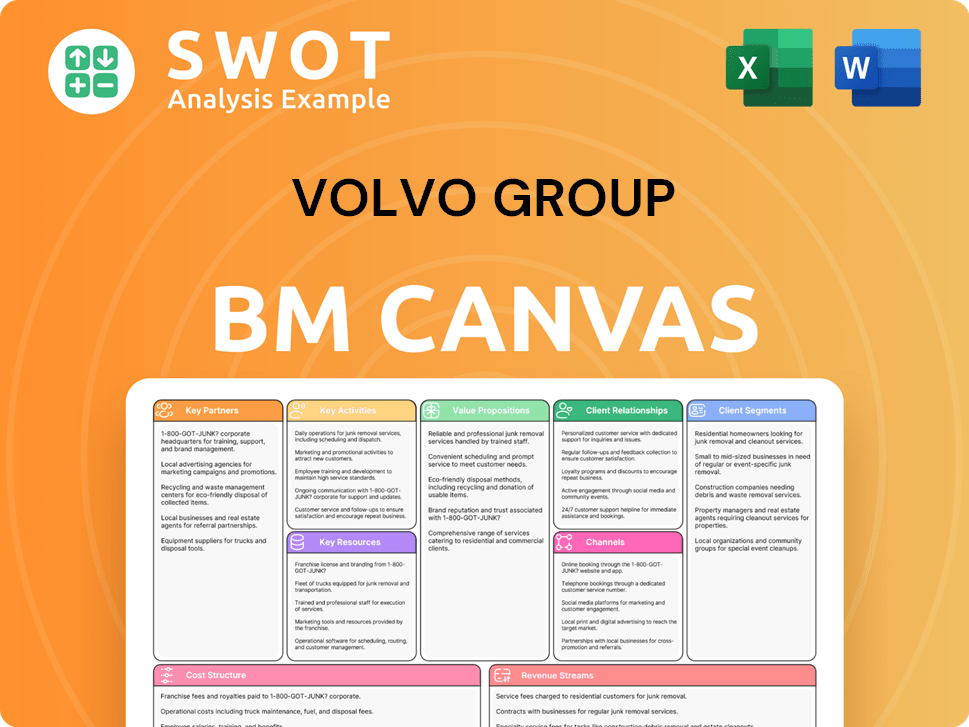
What is the Timeline of Key Events for Volvo Group?
The Volvo Group's journey began in 1927 in Gothenburg, Sweden, with the production of its first car, the ÖV 4. The company quickly expanded into the commercial vehicle sector, producing its first truck in 1928 and its first bus in 1932. A significant milestone was the introduction of the three-point safety belt in 1959, an open patent that revolutionized vehicle safety. The opening of the Torslanda car plant in 1964 marked a major production expansion. Further growth included the introduction of the Volvo FL truck series in 1982 and the acquisition of Renault Trucks in 2001 and Nissan Diesel (later UD Trucks) in 2007, strengthening its global presence. The company has shown continued innovation with the unveiling of Vera, an autonomous electric truck concept in 2018, and the start of sales for heavy-duty electric trucks in Europe in 2022. In 2024, Volvo Group demonstrated continued strong performance in order intake for trucks and construction equipment, despite supply chain and cost challenges.
| Year | Key Event |
|---|---|
| 1927 | Volvo Group founded in Gothenburg, Sweden; first car, the ÖV 4, produced. |
| 1928 | First Volvo truck produced, marking entry into commercial vehicle segment. |
| 1932 | First Volvo bus produced. |
| 1959 | Introduction of the three-point safety belt, an open patent for all manufacturers. |
| 1964 | Opening of the Torslanda car plant, a significant production expansion. |
| 1982 | Introduction of the Volvo FL truck series, known for urban distribution. |
| 1999 | Volvo Group sells Volvo Cars to Ford Motor Company, focusing on commercial vehicles. |
| 2001 | Acquisition of Renault Trucks, significantly expanding its truck operations. |
| 2007 | Acquisition of Nissan Diesel (later UD Trucks), further strengthening its position in Asia. |
| 2018 | Unveiling of Vera, an autonomous electric truck concept. |
| 2022 | Start of sales for heavy-duty electric trucks in Europe. |
| 2024 | Continued strong performance in order intake for trucks and construction equipment, despite ongoing supply chain and cost challenges. |
| 2025 | Expected continued investment in electric and autonomous solutions, with a focus on sustainable transport systems. |
Looking ahead,
Ongoing strategic initiatives involve developing new battery technologies and expanding charging infrastructure. The company is also accelerating the deployment of autonomous solutions in controlled environments such as mines and ports. The company is expanding its electric vehicle offerings across all segments, including buses and construction equipment.
Increasing urbanization, stricter emission regulations, and the demand for greater logistical efficiency are key industry drivers. Analyst predictions suggest continued growth in the electric truck market, where
Leadership statements emphasize
Volvo Group Porter's Five Forces Analysis
- Covers All 5 Competitive Forces in Detail
- Structured for Consultants, Students, and Founders
- 100% Editable in Microsoft Word & Excel
- Instant Digital Download – Use Immediately
- Compatible with Mac & PC – Fully Unlocked
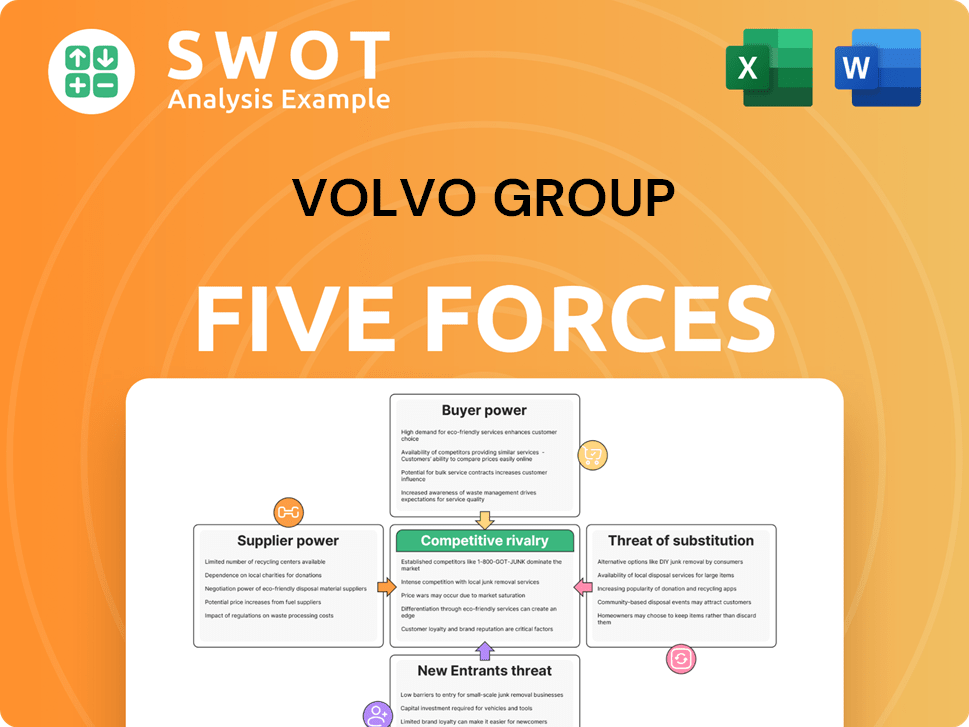
Related Blogs
- What is Competitive Landscape of Volvo Group Company?
- What is Growth Strategy and Future Prospects of Volvo Group Company?
- How Does Volvo Group Company Work?
- What is Sales and Marketing Strategy of Volvo Group Company?
- What is Brief History of Volvo Group Company?
- Who Owns Volvo Group Company?
- What is Customer Demographics and Target Market of Volvo Group Company?
Disclaimer
All information, articles, and product details provided on this website are for general informational and educational purposes only. We do not claim any ownership over, nor do we intend to infringe upon, any trademarks, copyrights, logos, brand names, or other intellectual property mentioned or depicted on this site. Such intellectual property remains the property of its respective owners, and any references here are made solely for identification or informational purposes, without implying any affiliation, endorsement, or partnership.
We make no representations or warranties, express or implied, regarding the accuracy, completeness, or suitability of any content or products presented. Nothing on this website should be construed as legal, tax, investment, financial, medical, or other professional advice. In addition, no part of this site—including articles or product references—constitutes a solicitation, recommendation, endorsement, advertisement, or offer to buy or sell any securities, franchises, or other financial instruments, particularly in jurisdictions where such activity would be unlawful.
All content is of a general nature and may not address the specific circumstances of any individual or entity. It is not a substitute for professional advice or services. Any actions you take based on the information provided here are strictly at your own risk. You accept full responsibility for any decisions or outcomes arising from your use of this website and agree to release us from any liability in connection with your use of, or reliance upon, the content or products found herein.